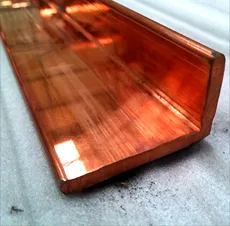1. Introduction
In a surprising twist this week, global copper prices surged past $9,000 per metric ton amid renewed infrastructure spending in the U.S. and EU—making every scrap of copper, from rod to strip, suddenly more valuable than your ex’s promises. As contractors, electricians, and recyclers scramble to optimize material choices, confusion reigns: Is a copper earth rod the same as a copper bonded ground rod? Can you really use a copper brazing rod for copper-to-copper welding? And why does your local hardware store charge wildly different copper rod prices for what looks like the same shiny metal?

Fear not! This guide cuts through the metallic fog with a humorous yet razor-sharp analysis of copper rods, their cousins (strips, bars, and pipes), and how to pick the right one without melting your budget—or your dignity.
2. The Many Faces of the Humble Copper Rod
Not all copper rods are created equal. In fact, calling them all ‘copper rod’ is like calling every dog a ‘fluffy.’ Sure, they bark (or conduct), but their breeds matter immensely.
2.1 Solid Copper Rod vs. Copper Bonded vs. Copper Clad
A true solid copper rod—often sold as copper round bar or round bar copper—is 100% pure copper (typically C10100 or C11000 grade). It’s the gold standard for high-conductivity applications like busbars, earthing systems in corrosive soils, and premium electrical connectors. Yes, it’s pricey—but you’re paying for performance that won’t quit.
Enter the imposters: copper bonded earthing rod and copper clad steel ground rod. Both feature a steel core for tensile strength, coated with copper. Copper bonded uses electroplating for a thicker layer (usually 0.25mm+), while copper clad steel earth rod uses metallurgical bonding. They’re cheaper and tougher mechanically—but beware: if the copper layer wears off during installation, corrosion accelerates faster than your Wi-Fi during a Zoom call.
- Solid copper rod: Best for longevity and conductivity; ideal for critical earthing or high-current bus bars.
- Copper bonded ground rod: Great balance of cost and performance; widely used in residential grounding.
- Copper clad earth rod: Budget-friendly but riskier in acidic or rocky soil; avoid for mission-critical sites.
2.2 Welding and Brazing: Not Just for Blacksmiths Anymore

Confused about copper welding rod vs. copper brazing rod? You’re not alone. Technically, you don’t ‘weld’ copper like steel—you usually braze it. True copper to copper welding rod exists but requires specialized techniques (like TIG with preheat) because copper dissipates heat like a gossipy neighbor spreads rumors.
For most DIYers and plumbers, copper brazing rods (often phosphorus-copper alloys) are the go-to. They melt at lower temps and flow beautifully into joints—perfect for copper pipework or aircon copper tube repairs. Remember: copper rod for welding isn’t always literal; sometimes it’s just filler metal labeled misleadingly.
Pro tip: Never use a generic ‘welding rod copper’ for electrical earthing—it lacks the purity needed for safe grounding!
3. Beyond Rods: Strips, Bars, and Pipes in the Copper Family
Copper doesn’t stop at rods. Enter copper strip—a flat cousin used everywhere from transformer windings to snail deterrents (yes, copper tape for snails is a real thing).
3.1 Copper Strip Showdown: Thin, Thick, and Nickel-Plated
Need flexible copper bus bar for a tight panel? Go for thin copper strips or nickel plated copper strip for added corrosion resistance. Building a grounding grid? Copper earth strip 25x3mm price varies by region, but expect to pay more for beryllium copper strip if you need springiness and strength.
And please—stop burning copper wire for scrap. Not only is it illegal in many places, but it ruins the metal’s resale value. The best way to strip copper wire? Mechanical strippers or automated machines. Fast way to strip copper cable? Invest in a decent rotary stripper—your fingers will thank you.

3.2 Copper Pipe Plumbing: Sizing, Soldering, and Sighing
While not rods, copper pipe tube systems rely on the same metallurgy. Whether it’s 15mm copper pipe for domestic water or 22mm pipe copper for mains, sizing matters. AC installers swear by air conditioning copper pipe for its ductility—just don’t forget proper copper pipe soldering technique to avoid leaks that drip slower than your motivation on Monday mornings.
4. Price Watch: What’s Driving Costs Up?
Copper rod price and copper strip price have jumped 12% this month alone. Why? Green energy projects, EV charging stations, and data centers are gobbling up every available ounce. Even copper ingot price reflects this frenzy.
If you’re shopping for copper bars for sale or a roll of copper strip, compare specs—not just labels. ‘Copper clad’ might sound premium, but if it’s mostly steel, you’re getting ripped off. Always ask: Is it solid, bonded, or clad?
5. Conclusion
Choosing the right copper product isn’t about grabbing the shiniest piece—it’s about matching material science to your project’s demands. Need reliability underground? Go solid copper earth rod. On a budget with decent soil? Copper bonded steel might suffice. Fixing an AC line? Stick to aircon copper pipe and proper brazing rods. And whatever you do, skip the backyard bonfire wire-stripping—recycling centers prefer clean, stripped copper, not charred regrets.
Our Website founded on October 17, 2012, is a high-tech enterprise committed to the research and development, production, processing, sales and technical services of ceramic relative materials such as Stop. Our products includes but not limited to Boron Carbide Ceramic Products, Boron Nitride Ceramic Products, Silicon Carbide Ceramic Products, Silicon Nitride Ceramic Products, Zirconium Dioxide Ceramic Products, etc. If you are interested, please feel free to contact us.

